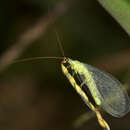Conservation Status
fourni par University of Alberta Museums
Not of concern.
- licence
- cc-by-nc
- droit d’auteur
- University of Alberta Museums
Cyclicity
fourni par University of Alberta Museums
Appear to be most abundant in late summer (Jubb and Mastellar (1977) as cited in Canard et al. (1984)).
- licence
- cc-by-nc
- droit d’auteur
- University of Alberta Museums
Distribution
fourni par University of Alberta Museums
Nearctic - C. oculata can be found throughout most of North America north of Mexico (Henry 1982).
- licence
- cc-by-nc
- droit d’auteur
- University of Alberta Museums
General Description
fourni par University of Alberta Museums
"Chrysopa oculata can be distinguished from other species by the following combination of characters: the frons has a darkly coloured ring around the lower or lateral margin of the base of the antenna; the antennal bases are not separated by an x-shaped mark as they are in C. chi; on the antennae, the pedicel is dark and the basal third of the flagellum is pale; there are small spots on the pronotum; the lateral groove of the vertex near the eye margin is completely pale.
Head - Scape unmarked. Antennae pale, darken distally. Maxillary and labial palps dark. Clypeus marks not extensive. Frons broad with black-brown band anteriorly and around antennae. Genae black from eye to base of mandibles. Two pair dorsolateral spots on vertex. Red-brown marks near dorsal rim of antennal sockets.
Thorax - Faint dots dorsolaterally. Setae mix of dark and light. Forewing crossveins dark at ends. Hindwing crossveins all dark. Setae on legs dark.
Abdomen - Setae amber-brown."
- licence
- cc-by-nc
- droit d’auteur
- University of Alberta Museums
Habitat
fourni par University of Alberta Museums
This species occurs in meadows with low vegetation, trees and field crops.
- licence
- cc-by-nc
- droit d’auteur
- University of Alberta Museums
Life Cycle
fourni par University of Alberta Museums
Chrysopa oculata is part of the oculata group, which all produce strong-smelling, offensive secretions (Henry 1982). Eggs are typically oval-shaped, and are borne at the top of a long stalk that is stuck to a substrate (Canard et al. 1984). Larvae generally overwinter in cocoons as diapausing third instars (Penny et al. 2000). They have been known to have up to three generations per summer (Henry 1982). Like other chrysopids, they produce courtship songs by bursts of abdominal vibrations; these songs are most likely related to species isolation (Henry 1982).
- licence
- cc-by-nc
- droit d’auteur
- University of Alberta Museums
Trophic Strategy
fourni par University of Alberta Museums
Adults and larvae are important predators of aphids, mites and soft-bodied arthropods in field and fruit crops in North America (McEwan et al. (2001), as cited in James (2006)).
- licence
- cc-by-nc
- droit d’auteur
- University of Alberta Museums
Chrysopa oculata
(
anglais
)
fourni par wikipedia EN
Chrysopa oculata is a species of green lacewing in the family Chrysopidae. It is found in North America and Central America.[1][2][3] This species was imported to New Zealand in 1926, as a way to control aphid populations, however did not establish in the country.[4]

Golden-eyed lacewing,
Chrysopa oculata
References
- licence
- cc-by-sa-3.0
- droit d’auteur
- Wikipedia authors and editors
Chrysopa oculata: Brief Summary
(
anglais
)
fourni par wikipedia EN
Chrysopa oculata is a species of green lacewing in the family Chrysopidae. It is found in North America and Central America. This species was imported to New Zealand in 1926, as a way to control aphid populations, however did not establish in the country.

Golden-eyed lacewing, Chrysopa oculata
- licence
- cc-by-sa-3.0
- droit d’auteur
- Wikipedia authors and editors
Chrysopa oculata
(
néerlandais ; flamand
)
fourni par wikipedia NL
Insecten Chrysopa oculata is een insect uit de familie van de gaasvliegen (Chrysopidae), die tot de orde netvleugeligen (Neuroptera) behoort.
Chrysopa oculata is voor het eerst wetenschappelijk beschreven door Say in 1839.[1]
Bronnen, noten en/of referenties Geplaatst op:
5-12-2011
Dit artikel is een beginnetje over biologie. U wordt uitgenodigd om op bewerken te klikken om uw kennis aan dit artikel toe te voegen.

- licence
- cc-by-sa-3.0
- droit d’auteur
- Wikipedia-auteurs en -editors
Chrysopa oculata
(
vietnamien
)
fourni par wikipedia VI
- licence
- cc-by-sa-3.0
- droit d’auteur
- Wikipedia tác giả và biên tập viên
Chrysopa oculata: Brief Summary
(
vietnamien
)
fourni par wikipedia VI
Chrysopa oculata là một loài côn trùng trong họ Chrysopidae thuộc bộ Neuroptera. Loài này được Say miêu tả năm 1839.
- licence
- cc-by-sa-3.0
- droit d’auteur
- Wikipedia tác giả và biên tập viên


 Golden-eyed lacewing, Chrysopa oculata
Golden-eyed lacewing, Chrysopa oculata